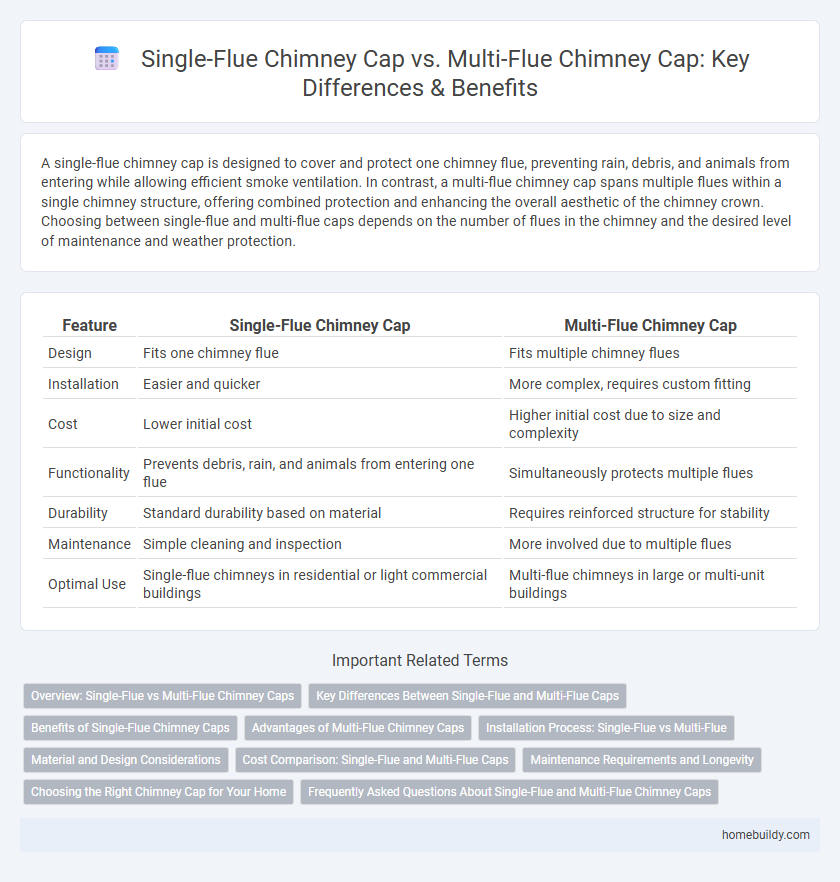A single-flue chimney cap is designed to cover and protect one chimney flue, preventing rain, debris, and animals from entering while allowing efficient smoke ventilation. In contrast, a multi-flue chimney cap spans multiple flues within a single chimney structure, offering combined protection and enhancing the overall aesthetic of the chimney crown. Choosing between single-flue and multi-flue caps depends on the number of flues in the chimney and the desired level of maintenance and weather protection.
Table of Comparison
| Feature | Single-Flue Chimney Cap | Multi-Flue Chimney Cap |
|---|---|---|
| Design | Fits one chimney flue | Fits multiple chimney flues |
| Installation | Easier and quicker | More complex, requires custom fitting |
| Cost | Lower initial cost | Higher initial cost due to size and complexity |
| Functionality | Prevents debris, rain, and animals from entering one flue | Simultaneously protects multiple flues |
| Durability | Standard durability based on material | Requires reinforced structure for stability |
| Maintenance | Simple cleaning and inspection | More involved due to multiple flues |
| Optimal Use | Single-flue chimneys in residential or light commercial buildings | Multi-flue chimneys in large or multi-unit buildings |
Overview: Single-Flue vs Multi-Flue Chimney Caps
Single-flue chimney caps are designed to cover and protect a single chimney flue, preventing rain, debris, and animals from entering while allowing smoke to exit efficiently. Multi-flue chimney caps accommodate multiple flues in one unit, providing a streamlined solution for chimneys with two or more flues, reducing installation complexity and improving overall draft performance. Both types are essential for preserving chimney integrity, but proper selection depends on the number of flues and specific ventilation requirements.
Key Differences Between Single-Flue and Multi-Flue Caps
Single-flue chimney caps are designed to fit over a single chimney flue, providing protection against rain, debris, and animals while ensuring proper draft for one vent. Multi-flue chimney caps cover multiple flues simultaneously, offering consolidated protection and enhancing the aesthetic appeal by unifying several chimneys with one cap structure. Key differences include installation complexity, size requirements, and ventilation efficiency, with single-flue caps typically easier to install and multi-flue caps requiring precise measurements to accommodate several flue openings securely.
Benefits of Single-Flue Chimney Caps
Single-flue chimney caps provide targeted protection by effectively preventing rain, debris, and animals from entering a specific chimney flue, enhancing draft efficiency and reducing moisture-related damage. These caps are easier to install and maintain, often costing less than multi-flue models, making them ideal for homeowners with single-flue fireplaces. Their precise fit ensures optimal ventilation control, improving safety and energy efficiency in residential heating systems.
Advantages of Multi-Flue Chimney Caps
Multi-flue chimney caps offer superior protection by covering multiple flues with a single unit, reducing installation complexity and overall cost compared to multiple single-flue caps. These caps enhance draft efficiency by preventing downdrafts across all connected flues and protect against rain, debris, and animal intrusion simultaneously. Their durable construction materials, such as stainless steel or copper, ensure long-lasting corrosion resistance and minimal maintenance requirements.
Installation Process: Single-Flue vs Multi-Flue
The installation process for a single-flue chimney cap is generally quicker and less complex, involving securing one cap directly over the sole flue, which reduces time and labor costs. Multi-flue chimney cap installation requires precise measurements and fitting for multiple openings, demanding more skill and specialized tools to ensure each flue is properly sealed and protected. Proper installation is critical for both types to prevent water damage, animal intrusion, and ensure optimal draft performance.
Material and Design Considerations
Single-flue chimney caps are typically constructed from stainless steel or copper, designed to fit snugly over one chimney flue, providing optimal protection against rain, debris, and animals. Multi-flue chimney caps require larger, more robust materials like galvanized steel or custom-fabricated copper, with designs that incorporate multiple enclosed openings to ensure each flue is properly sealed and ventilated. Material durability and precision-engineered designs are crucial for multi-flue caps to withstand diverse weather conditions and prevent cross-contamination between flues.
Cost Comparison: Single-Flue and Multi-Flue Caps
Single-flue chimney caps generally cost between $50 and $100, making them more affordable for homeowners with one chimney flue. Multi-flue chimney caps range from $150 to $400 due to larger sizes and more complex designs needed to cover multiple flues. Installation fees vary, but multi-flue caps typically require higher labor costs reflecting increased complexity and materials.
Maintenance Requirements and Longevity
Single-flue chimney caps require less maintenance due to their simpler design and easier access for cleaning and inspection, typically lasting 10 to 15 years depending on material quality and environmental conditions. Multi-flue chimney caps demand more frequent maintenance because their complex structure can trap debris and moisture, potentially reducing their lifespan to 7 to 12 years without regular upkeep. Selecting corrosion-resistant materials like stainless steel or copper enhances the longevity of both single-flue and multi-flue chimney caps, minimizing maintenance frequency and extending operational life.
Choosing the Right Chimney Cap for Your Home
Single-flue chimney caps are designed to fit over one chimney flue, providing protection from rain, debris, and animals for a single exhaust outlet, ideal for homes with one fireplace or stove. Multi-flue chimney caps cover multiple flues within a shared chimney structure, ensuring comprehensive protection and ventilation while preventing downdrafts and water damage in homes with several fireplaces or heating appliances. Selecting the right chimney cap depends on the number of flues and the specific ventilation needs of your home's heating system.
Frequently Asked Questions About Single-Flue and Multi-Flue Chimney Caps
Single-flue chimney caps are designed to cover one chimney flue, preventing rain, debris, and animals from entering while allowing smoke to vent efficiently. Multi-flue chimney caps cover multiple flues within the same chimney structure, often requiring custom sizing to ensure proper fit and ventilation. Homeowners frequently ask about installation differences, maintenance needs, and whether a multi-flue cap can replace multiple single-flue caps to improve cost and weather protection.
Single-flue chimney cap vs Multi-flue chimney cap Infographic

 homebuildy.com
homebuildy.com